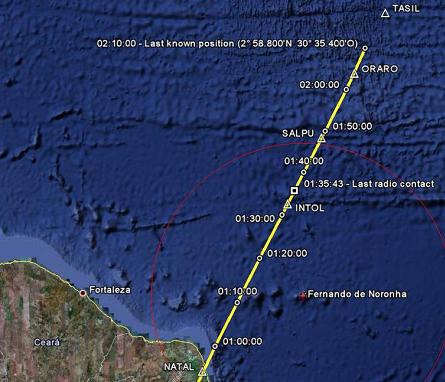Initial details of the handover of Air France flight AF447 from Brazil to Senegal have opened a rift between the two states, as investigators attempt to establish how long the Airbus A330 was out of contact before a formal emergency alert was declared.
Preliminary findings into the loss of the AF447 indicate that, after the jet failed to respond to radio calls shortly before leaving Brazilian airspace, several hours elapsed while controllers in 10 different flight information regions tried to determine the aircraft's position.
Circumstances of the loss - close to the Brazil-Senegal oceanic airspace boundary, where responsibility for the flight is handed over - have made the transfer issue a sensitive matter.
France's Bureau d'Enquetes et d'Analyses (BEA) states that the flight "was not transferred" between Brazil's Atlantico and Senegal's Dakar oceanic centres. This has been backed by West African air navigation service ASECNA.
But the Brazilian air force says it wants to "eliminate doubts" about the procedures followed. It has publicly issued an audio segment of the moment the Atlantico controller co-ordinated transfer of AF447 to Dakar, when the A330 was estimating reaching the Brazil-Senegal airspace boundary - the waypoint designated TASIL - at 02:20UTC.
Only changes in excess of 3min to this estimated time would have required further co-ordination with Dakar. But the estimate was never revised because the Atlantico controller could not raise AF447 after the last radio contact at 01:35UTC.
As a result, argues the air force, Dakar "theoretically" assumed control of the aircraft at 02:20UTC.
 |
|---|
© Bureau d'Enquetes et d'Analyses |
But in a statement ASECNA claims the "onus" was on the Atlantico controller to call his counterpart at Dakar centre to confirm the aircraft's arrival at the airspace boundary. "This formality was not performed," it says, and the aircraft did not contact Dakar to "signal its presence".
ASECNA rejects as "totally unfounded" the Brazilian suggestion that aircraft can be assumed to have entered Dakar airspace if the Dakar centre does not warn otherwise.
But BEA's interim report into the crash highlights a September 2008 agreement between the Atlantico and Dakar centres which was in force at the time of the crash.
This states that air crews must contact the receiving sector controller 5min before the airspace boundary, but also that controllers in the receiving sector must inform the exiting sector if they cannot establish contact with an aircraft within 3min of the estimated time of arrival.
BEA warns against drawing early conclusions over the search and rescue situation, stating that its chronology of subsequent air traffic control communications is "still fragmentary".
But the interim report states that Dakar controllers worked with a 'virtual' track of AF447 in the absence of radio contact and a confirmed trajectory. There was no log-on to the Dakar automatic dependent surveillance tracking system.
Some 28 minutes after the estimated entry of AF447 into Dakar oceanic airspace, the Dakar controller informed the adjacent centre, Cape Verde Sal, that the aircraft had not yet made contact. More than an hour later, at 03:54UTC, with AF447 running 9min behind the projected time to enter Sal airspace, Sal called Dakar for an update, and was told that AF447 had not contacted Dakar to revise its estimates.
Sal informed Dakar at 04:07UTC that it was tracking a second Air France flight, AF459, which had been some 37min behind AF447. This second aircraft failed to raise AF447 on the radio.
At 04:21UTC Dakar called Atlantico centre to confirm the whether AF447 had exited Brazilian airspace at TASIL in line with the original estimate.
BEA's partial chronology does not yet include full information from the Atlantico and Sal centres. But the Brazilian air force states that, after Dakar queried AF447's position with Atlantico, the Recife-based Salvaero search and rescue division "initiated necessary actions to start air operations to locate the missing aircraft" at 05:20UTC.
By this time Air France was also trying to confirm the flight's position and, over a period of about three hours, the carrier and several other control centres - among them Canarias, Santa Maria, Casablanca, Lisboa, Madrid and Brest - exchanged information in a bid to establish the aircraft's whereabouts. At one stage, the BEA chronology shows, the flight was erroneously reported to have been in contact with Moroccan air traffic control.
Air France and Brest centre informed BEA of the situation shortly after 07:41UTC. Madrid centre issued an 'alert' emergency phase at 08:15UTC and Brest launched a 'distress' phase about 20min later.
Source: Air Transport Intelligence news



















